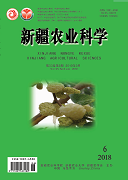|
|
Clonal Analysis of kfpSPL Gene and Its Promoter in Korla Fragrant Pear (Pyrus sinkiangensis)
WANG Yu-kai, ZHAO Huan, NIU Jian-xin
2018, 55(6):
1017-1026.
DOI: 10.6048/j.issn.1001-4330.2018.06.005
【Objective】 'Korla fragrant pear' is an important economic crop in the Xinjiang Uyghur Autonomous Region of China. The nutritious, fragrant, and tasty fruit is exported to all parts of the world. Korla fragrant pear can have both a persistent and a deciduous calyx. The persistent calyx causes the fruit to be deformed, thus reducing its market value. The objective of this study was to clone and analyze the sequence of the Korla fragrant pear SPL (kfpSPL) gene and its promoter.【Method】Flowers of Korla fragrant pear were collected in an orchard at Shayidong, Korla, Xinjiang. The first flowers to open in a cluster during full bloom were collected from three trees. The flowers were immediately frozen in liquid N and stored at -70°C. Primer Premier 5.0 software was used to design a pair of primers based on the cDNA sequence of the kfpSPL gene as well as genomic information from P. bretschneideri. The specificity of the primers was verified by sequencing. Genomic DNA was isolated from the flower samples using a plant genome extraction kit (Tiangen, Beijing, China) and quantified using an ultramicroprotein nucleic acid analyzer (NANODrop 2000, Thermo, USA). The quality of both the genomic DNA and the upstream regulatory sequence of kfpSPL was verified using agarose gel electrophoresis (1%). The local BLAST program was used to analyze the similarity of the nucleotide sequences. DNAMAN software was then used to analyze and edit the genomic DNA and upstream regulatory sequence of kfpSPL. Two databases, PLACE and Plant Care, were used to analyze and predict the promoter's cis-acting elements.【Result】A genomic DNA sequence with a length of 3,320 bp and an upstream regulatory sequence with a length of 2,332 bp were obtained by PCR. The DNA of the genome was 99% homologous to a sequence of the same length in the P. bretschneideri scaffold. The E value was 0. A sequence (301708-305026 nt) in scaffold 291.0 loci corresponded with an upstream regulatory sequence (300845-300878 nt) in the P. bretschneideri scaffold. The sequences had 85% homology. The E value was 2.7. The genomic DNA sequence of kfpSPL had three introns and a total length of 1,728 bp. The first intron was located at 407-949 nt in the genomic DNA, the second intron was at 962-2,386 nt, and the third intron was at 2,530-2,673 nt. The promoter sequence of the clone was searched in the database of the pear genome sequence. The 1-796 and 1,042-2,332 nt positions of the upstream promoter sequence of kfpSPL were respectively compared with the 290,783-289,988 and 289,990-288,701 nt positions in scaffold291.0 of the pear genome sequence database. The homologies were 96% and 97% and the E value was 0. The upstream promoter sequence of kfpSPL was slightly different than the upstream promoter sequence of Dangshan Pear in scaffold 291.0. The 797-1,041 nt position of the upstream promoter sequence of kfpSPL did not match the pear genome sequence database, indicating that intervarietal differences existed between Korla pear and Dangshan Pear. Insertion mutations were observed at 161-162, 1,345-1,350, 1,375-1,377, and 2,129-2,137 nt in the upstream promoter sequence of kfpSPL. Bioinformatics analysis showed that the kfpSPL promoter sequence included transcriptional regulatory elements related to hormonal regulation, including Gibberellin-responsive cis-acting elements (GARE-motif and P-box), light responsive cis-acting elements (ACE, Box II, CATT-motif, G-box, TCT-motif, and Box4), defense and stress responsive cis-acting element (TC-rich repeats), promoter and enhancer region cis-acting elements (CAAT-box), and core promoter element of transcription start cis-acting elements (TATA-box). 【Conclusion】In this study, we cloned and analyzed (i) the DNA sequence of the kfpSPL genome and (ii) the upstream regulatory sequence of kfpSPL. The kfpSPL promoter sequence has gibberellin-responsive cis-acting elements, light responsive cis-acting elements, wound responsive cis-acting elements, jasmonic acid responsive cis-acting element, salicylic acid reactive component, promoter and enhancer regions cis-acting elements, shedding acid reaction cis-acting elements, high transcriptional horizontal cis-acting elements, meristematic tissue expresses the cis-acting element, and the endosperm expresses the cis-acting regulatory elements. The numerous cis-acting elements suggest that growth regulators can regulate the expression level of kfpSPL genes in the calyx. Previous research findings in our laboratory indicated that the expression of the kfpSPL gene was increased by ABA, ETH and NAA. Furthermore, the influence of PBO and GA on kfpSPL expression varied depending on the time after treatment and on tree vigor (flowers on trees with high vigor had a persistent calyx, whereas those on trees with low vigor had a deciduous calyx). The results suggest that the kfpSPL gene may have some control over hormones in the calyx of Korla fragrant pear. Therefore, these treatments may affect calyx persistence in Korla fragrant pear. Overall, the results indicate that many cis-acting elements are significant to the transcription and regulation of the kfpSPL gene. Additional studies are needed to determine how these cis-acting elements specifically regulate the expression of the kfpSPL gene.
|

